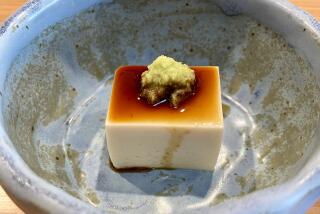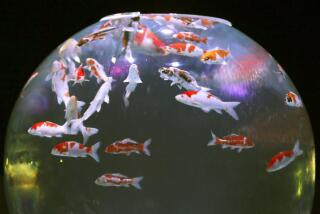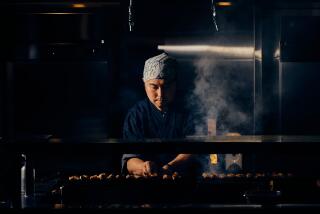Guidelines Issued to Prevent Poisonings : Deadly Blowfish a Taste Treat in Japan
TOKYO — Pity the poor blowfish. It has had such a bad press. Even in Japan where the puffer is king, the emperor is not allowed to taste it because of its dread reputation.
The spiky creature, which inflates itself when angry or frightened, can pack a poison 25 times more powerful than cyanide. But prepared the right way it is no more dangerous than a plate of conventional fish.
Before the Japanese government established guidelines on training chefs just after World War II to prevent poisonings, hundreds of unwary diners fell victim to the fish each year.
The British explorer Capt. James Cook, on a voyage to New Caledonia in the 18th Century, wrote how he and his crew nearly died after eating blowfish.
Deadly but Relished
In Ian Fleming’s “From Russia With Love,” James Bond is nearly done in by blowfish poison.
In real life, Mitsugoro Bando, a Kabuki actor who was proclaimed a Living National Treasure, died in 1975 after eating four poisonous blowfish livers.
The Ministry of Health and Welfare said six people died of blowfish poisoning last year. Another 38 became seriously ill but survived.
An American anthropologist has also suggested that the fish poison is used in aspects of Haitian voodoo.
Yet the Japanese swear by the fish, as do foreign gourmets who ignore warnings from the timid and relish the flavor of the blowfish, known in Japanese as fugu .
Fugu aficionados say the fish, whose flesh has trace amounts of the male hormone testosterone, is an aphrodisiac.
Fried, Stewed or Dipped
Less dramatically, its light, refreshing taste is easy on the palate. It can be deep-fried, stewed in broth or eaten raw, dipped in a pungent pepper and citrus sauce.
The doyenne of Tokyo fugu restaurateurs, Michiyo Kawashima, agreed to an interview on the condition that the more benign culinary aspects of blowfish were also documented.
Kawashima, wearing an impeccable silk kimono, said after a five-course fugu feast that her 56-year-old establishment Fukugen has never lost a customer.
“We care as much about our reputation as about your life,” she said. “If any of our clientele died, that would be the end of our business.”
The cause of the trepidation is an undeniably deadly cache of the poison tetrodotoxin in the fugu’s internal organs, especially the ovaries, kidneys and liver.
Hazards Taken Seriously
A single concentrated ounce of tetrodotoxin is 500 to 1,000 times stronger than the same amount of potassium cyanide, and there is no antidote.
Death by blowfish poisoning occurs within about 30 minutes to an hour. Victims have described a euphoric “high” and a gradual numbing of the body while the brain continues to function.
The Japanese, who every year consume about 7,000 tons of fugu, take the hazards of eating blowfish seriously.
All fugu chefs must pass a tough government-supervised examination, which tests their knowledge of more than a dozen species of the fish and how to bypass the poison.
Of the 838 would-be fugu chefs who took the annual examination in Tokyo this year, only 324 passed.
King of Blowfish Chefs
Because of the dangers, fugu is not freely available in shops. Only the proprietor of a recognized restaurant with licensed fugu chefs can buy the fish.
Tsutomu Sato, reputed to be the king of blowfish chefs, has worked for 28 years at Kawashima’s Fukugen restaurant.
Deftly slicing through a fugu fillet, he fashions a translucent chrysanthemum pattern on a snow-white porcelain platter.
“It takes about 10 years to become a full-fledged chef,” Sato said. Kawashima said he began learning at 14 and was a master chef by the unusually early age of 22. The average chef is 30 before he gets his license.
Expensive Dinner
Each night after the last Fukugen customer is bowed into his car, Kawashima places her orders for fugu with the fish market in the western city of Shimonoseki, the center for all of Japan’s fugu supplies.
More to Read
Sign up for Essential California
The most important California stories and recommendations in your inbox every morning.
You may occasionally receive promotional content from the Los Angeles Times.










